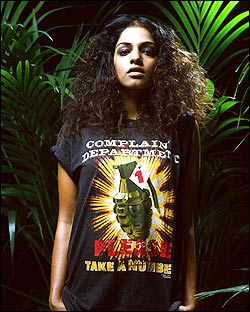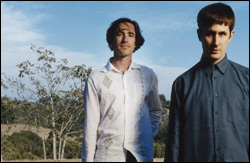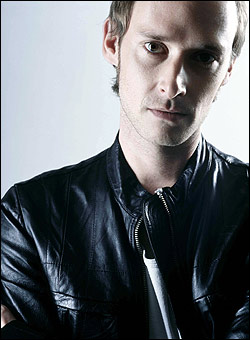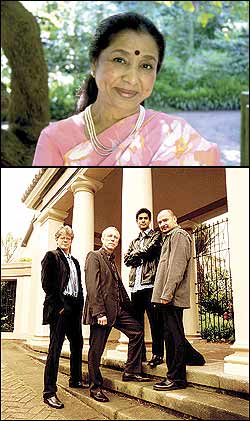In physicist Roger Penrose’s hefty new tome, The Road to Reality—a book about the universe, written for a general audience but densely packed with mind-bending equations—he offers that his book can be enjoyed at four different levels. Level 1 readers follow the flow and general concepts of the book, appreciating the thorny-but-cool equations and diagrams on aesthetic terms. Level 4 is for the folks who battle with the material in all its weird mathematical contortions, convolutions, and connotations.
There seem to be four different levels for listening to M.I.A.’s debut, Arular, which was due out two weeks ago on XL but whose release has been held back either due to a sample-clearance issue, according to the official press release, or because a major label is trying to snap it up, according to popular rumor. M.I.A., aka Maya Arulpragasam, is a 28-year-old London artist of Sri Lankan descent. Here’s the 30-second Level 1 crash course: She’s gorgeous; she has friends and admirers in high places (Jay-Z and P. Diddy have both expressed interest in her album, and she’s buddies with Pulp and Elastica); she has her finger on the pulse of what’s hot (she told The New York Times that her current faves were—swoon!—dancehall, reggaeton, Rio baile funk, and grime); she’s a talented visual artist. And the album, a strange yet thoroughly pop synthesis of the aforementioned faves, topped with her singsongy, patois-laden drawl, is great. The big, stomping beats—in no small part thanks to Philly DJ Diplo and the production talents of Richard X and Pulp’s Steve Mackey—are hot! I can dance to it! What’s not to like?
Level 2 is a bit thornier. Arular‘s lyrics don’t seem to mean much, but they’re catchy as all hell: “Blaze to blaze, galang-a-lang-a-lang-a/Purple haze, galang-a-lang-a-lang,” she sings on “Galang,” her debut single from last year. You notice a few other catchphrases, too, like “freedom fighter,” “Pull up the people/Pull up the poor,” and “I got the bombs to make you blow/I got the beats to make you bang.” Whatever—none of this means much, in and of itself. Intrigued, you go to her incredibly psychedelic Web site (www.miauk.com) and wait for a Flash animation to load. The graphic shown on the screen while you wait is a cute cartoon image of bundled sticks of dynamite, ready to explode. You read her bio and see that she had a rough childhood; she lived in war-torn Sri Lanka as a kid, and her father wasn’t around much. He was in the Tamil Tigers, where his nickname was “Arular”—the title of M.I.A.’s album. You don’t know much about the Tamil Tigers, besides the fact that they don’t seem to be a baseball team, and read on. It looks like she moved to the U.K. with her mother as a refugee a little over 15 years ago. Since then, she’s turned her life around, graduating from a top British art school and making a name for herself by playing with loaded images, tearing them out of context and throwing them onto canvases: bright, Warhol-esque screen prints of war and strife, from guns and bombs to tigers.
Then there’s Level 3. Look up more about M.I.A. online and you’ll find dozens upon dozens of fawning articles in arts sections, along with just as many rapid-fire debates raging about her on numerous blogs, the I Love Music message board (www.ilxor.com), and now in the press. One big debate is the old “street cred” one: Is Arulpragasam the real deal, or is she just a London fashion type, capitalizing on hot under-the-radar ghetto genres and her dad’s fiery past? But another related discussion is of M.I.A.’s politics and her strange, contradictory way of broadcasting them. Who are the Tamil Tigers, what does M.I.A. have to do with them, and what’s this candy-colored political iconography all about? Is it just to shock people and get attention, the way Siouxsie Sioux did when she wore a swastika armband in 1977?
Finally, we come to Level 4: You immerse yourself in the story of the Tamil Tigers, also known as the LTTE. A good starting point is Robert Christgau’s essay in last week’s Village Voice, where he asks some tough questions and does his homework about the LTTE to find out. Here’s your 30-second Level 4 crash course: There are two main ethnic groups in Sri Lanka, the majority Sinhalese (Buddhists) and the minority Tamils (Hindus). The LTTE is a militialike organization that, for decades, has fought Sinhalese oppression, infamously using highly questionable methods to do so—suicide bombing, for one, being an LTTE hallmark. Was M.I.A.’s dad, Arular, a martyr for the cause, a revolutionary, or—to use a phrase Christgau explicitly disdains—a “freedom fighter”? It’s difficult to tell who’s right and who’s wrong. But it does make you think twice about a line like “I got the bombs to make you blow,” and makes you think a lot more times than twice about a tossed-off line like “Like PLO, we don’t surrend-o.”
M.I.A. is playing with fire, and she knows it. As long as she keeps pumping out tunes as groovy as “Galang,” “Sunshowers,” and “Bingo,” she’ll keep rocking dance floors from Seattle to South Beach. She doesn’t have a political agenda that stays put (mere seconds before the PLO line, she says, “Can’t stereotype my thing, yo/I salt and pepper my mango”—er, what?). But that doesn’t mean we shouldn’t try to wrestle with Arular‘s equations and diagrams, incomprehensible as they may be, while we dance to them.
M.I.A. plays Chop Suey at 8 p.m. Tues., March 16. $12 adv.







